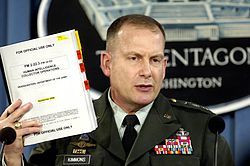

United States Army Field Manuals are published by the United States Army's Army Publishing Directorate. They contain detailed information and how-tos for procedures important to soldiers serving in the field.
Contents
As of July 2007, some 542 field manuals were in use. [1] [ needs update ] Starting in 2010, the U.S. Army began review and revision of all of its doctrinal publications, under the initiative "Doctrine 2015". Since then, the most important doctrine have been published in Army Doctrine Publications (ADP) and Army Doctrine Reference Publications (ADRP), replacing the former key Field Manuals. Army Techniques Publications (ATP), Army Training Circulars (TC), and Army Technical Manuals (TM) round out the new suite of doctrinal publications. Not all FMs are being rescinded; 50 select Field Manuals will continue to be published, periodically reviewed and revised. They are usually available to the public at low cost or free electronically. Many websites have begun collecting PDF versions of Army Field Manuals, Technical Manuals, and Weapon Manuals. [2] The Library of Congress maintains a list of every Field Manual published between the 1940s to the 1970s. [3]